Restoring a 1940 Packard One-Twenty Sedan, Pt. 1
After Resting In a Field for Years, This Car Had a New Owner. He Figured That One Packard In His Garage Wasn’t Enough.
IN THE Spring of 2005, an abandoned 1940 Packard One-Twenty Sedan was spotted sitting among the weeds, devil’s cane and fire ants near Texarkana, Arkansas, by vintage car hobbyist Jimmy Blackburn. The car had been sitting there alongside a 1956 Cadillac Coupe deVille for decades, but was amazingly intact. It had never been used for target practice or other such vandals’ acts. All parts were present; however, leaks had allowed water into the interior and trunk compartments resulting in the inevitable chemical reaction known as rust. Rust had also infected the drip rail on both sides. As one would expect, the interior looked like a nesting place for rodents and other critters. Given all that, many old car hobbyists would have seen this Packard as a parts car rather than a restoration project.
But then Blackburn told a fellow Packard Automobile Club (Ark-La-Tex Packards region) member, Nelson Bates, about his discovery. Soon Bates made the 100-mile trip to inspect the Packard and saw its potential. He was not looking at the rusted Packard through rose-colored glasses at the time either. By this point, Bates (who is an electrical engineer) was an experienced restorer having recently completed a seven-year restoration of a 1940 Packard One-Ten Business Coupe. His experience with that project — a car he considered to have been in worse condition than the One-Twenty Sedan that had been sitting in the elements — made him an expert on restoring a ’40 Packard. He literally knew every nut, bolt and washer of this make and model. As Bates’ brother, Warren, said on restoring such a car, “If you can live through it, you will be a better person.” Bates’ survival of the first one definitely made him a better auto restorer when the second project came along.
Incidentally, Bates also acquired the ’56 Cadillac and gave it to Chad Aggen, the man who would be handling the extensive body work and painting of the Packard, in exchange for his help in getting the car out of its harsh surroundings and onto a trailer. Unfortunately, the Caddy did not fare as well as the Packard. Upon moving the Cadillac From its cocoon, its frame broke apart. Fortunately, the frame underneath the Packard was solid.
The Project Begins
With the idea that two restored 1940 Packards are better than one, the restoration of the One-Twenty Sedan soon began after its arrival in Longview, Texas, (between Dallas and Shreveport, Louisiana). The first chore to be done was to remove all of the accumulated debris including leaves and insect and rat nests. This part of the project should be considered hazardous. Therefore, wearing a particulate mask is strongly recommended.
The interior was then removed. (During the process a rat jumped out and ran across Bates’ arm, thus demonstrating one of the more creepy aspects of auto restoration.)
All debris was thoroughly sifted over a period of days to find any lose components of the car and many were found, identified and bagged. Upholstery samples were also put aside for future reference. Nothing was thrown away; if it was not restorable it could be used for reference. This is a point Bates emphasized for this article. For example, he knows of times when rotted upholstery was trashed early in the restoration process, but when the time came to replicate the interior there were no samples remaining to use for matching.
Next the glass, engine and transmission, as well as the front end were removed.
The One-Twenty was then hauled to Rods & Restorations in Longview where it would remain for quite some time with Chad Aggen.
The Packard Hierarchy: A Six, Eight & Twelve, Plus the Darrin
Before we go any further with this restoration, let’s take a quick look at what Packard was offering in the pre-war years.
For the 1937 model year (or in Packard speak, the Fifteenth Series) Packard introduced its first six-cylinder model since 1928; it was dubbed the One-Ten, aka, the Model 115C. It became the company’s offering in the under-$750 price market which covered about 95 percent of the cars then sold in the U.S.
The inline eight-cylinder One-Twenty was the next step up the ladder followed by the Super-Eight and the Twelve. As one would expect, the Twelve was the highly luxurious twelve-cylinder model. The custom-bodied Packard Darrin, though, was at the uppermost in the hierarchy.
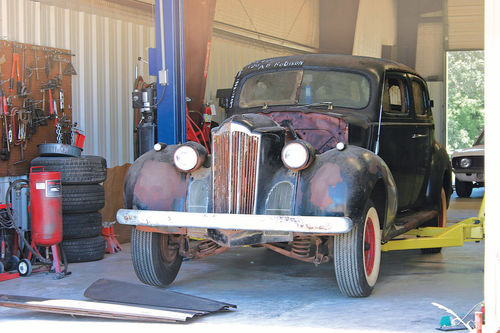
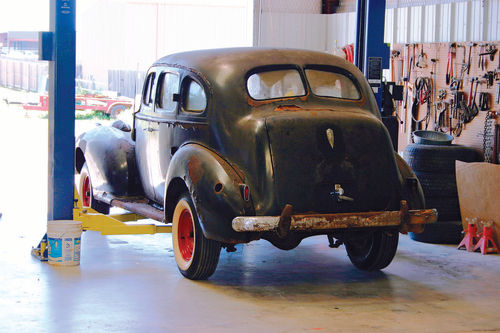
The following model year the OneTen and One-Twenty series’ names were changed to the Packard Six and Packard Eight while the so-called senior cars again were designated as the Super-Eight and the Twelve.
The One-Twenty designation was brought back for the 1939 model year replacing the Packard Eight designation used the previous year.
For ’40 or the Eighteenth Series, the One-Ten name returned, joining again with the One-Twenty. Together, they generally are known as the “junior” models.
Meanwhile, a significant change occurred in the senior model lineup for 1940. In the top spots were the Super Eight One-Sixty and the Custom Super Eight One-Eighty. Both cars had a 356 cid, nine-bearing, 160 hp straight-eight and shared the same chassis components. However, the One-Eighty had a more luxurious interior. The Twelve was dropped, although the Darrin was still offered.
In a nutshell, Packard offered four lines of automobiles for the 1940 model year. Six body styles were offered in the One-Ten; eight styles in the One-Twenty line; nine body styles for the Super Eight One-Sixty series and 10 for the Custom Super Eight One-Eighty. Each body style was assigned a body code. For instance, the code for Nelson Bates’ One-Twenty Touring four-door sedan is 1392.
Packard brought out the lower-priced junior cars to help it survive the Great Depression — an era in which many luxury car manufacturers went bankrupt. (For ’40, nearly 64 percent of Packard sales were their One-Ten offerings.) The maneuver worked — making the late ’30s through the early ’40s the best years the company would ever have — and helped to keep the company alive until the ’50s when its sales dropped dramatically due to Packard’s failure to introduce a modern V-8 until it was too late. A merger with Studebaker in 1954 did not solve the problem and the Packard name was dropped by Studebaker after the 1958 model year.
Extensive Body Repairs are Called For Here Now, back to our project.
Final disassembly was performed at the shop. With all the rusty panels exposed, replacement with new sheet metal could commence. Front and rear floor pans, areas of the rockers, rear inner wheel wells, the trunk floor and trunk gutter, and the panel running the width of the body under the deck lid needed replacement. These sections were cut away and in most cases served as patterns. New pans and other sections were cut from 20-gauge steel and formed with shrinker/stretchers to get all the shapes correct. A bead roller was used to finish the shaping. (Reproduction floor pans became available after the bodywork was completed.)
A parts car donated its upper trunk gutter to be used for the new lower gutter. It was a near perfect fit and required only a small amount of adjustment.
Numerous Coats of Primer, Paint and Clear Coat Were Applied
Along the way, Bates chose Centennial Blue, an authentic color, as the choice to paint his car (which originally was black). The One-Twenty’s body was sandblasted clean with #6 sugar sand followed by application of U-Tech epoxy primer.
The process of preparing a paintable surface began with two coats of U-Tech E380 primer/sealer. This was followed by bolting the body back together to finetune the panel alignment. Three coats of U-Tech 2K20 primer surfacer went on next followed by dry block sanding with 150- grit then 180-grit sandpaper. Afterward, more 2K20 primer surfacer was applied. This was dry block sanded with 320-grit sandpaper followed by another refit of all body panels. Three coats of U-Tech base coat followed by three coats of U-Tech 4.0 clear coat were sprayed on and allowed to air dry. (In the Texas summer this almost amounts to baking the paint.) Once dry, color sanding began with 800-grit progressing to 1500. That led to buffing with a wool pad, then a medium foam pad, and lastly a fine foam pad, all of which resulted in a smooth, high-gloss finish. Six months later the car was hand waxed.
Finding Body Panels and Exterior Hardware Isn’t Easy
With the passage of some seven decades since they were new, restorable Packards of this era are becoming quite uncommon. Finding them with every body panel in relatively good, repairable condition is much more uncommon.
Unfortunately for the restorer there also are some one-year-only body parts on the ’40 Packards.

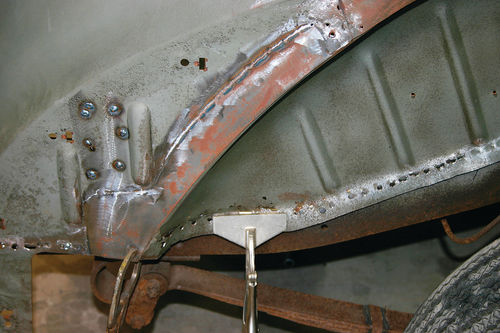

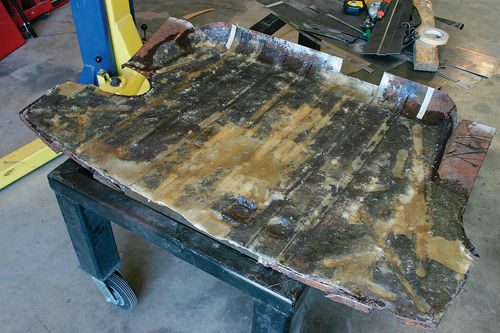
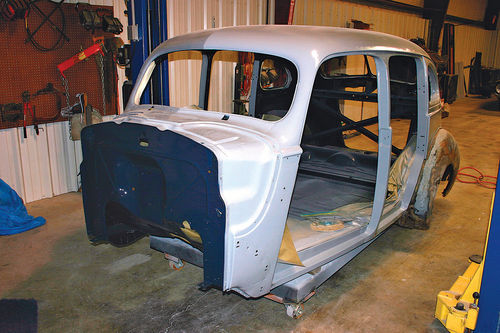
Front and rear fenders are unique to the 1940 Packards. A common fallacy among restorers is the belief that 1938-40 fenders interchange. While a 1938/39 fender can be bolted onto a 1940 model, they are not the same. Those for 1940 had a smaller wheel opening. Furthermore, parking lamps were mounted on the front fenders for ’40 and were drilled at the factory to accept them. Possibly of some help to the restorer is the fact Packard dealers would use 1940 front fenders to repair a 1938 and 1939 model; therefore, the possibility exists that 1940 fenders can still be sourced from the earlier cars. On the flip side, the limited-production Packard Darrin — a highly desirable car to Packard collectors — has been responsible for depleting the supply of rear fenders for the other 1940 Packards. Two rear fenders can be grafted together to make a Darrin fender. All other 1940 Packards used the same rear fender regardless of the mod - el. However, the front fenders are shorter on the six-cylinder One-Ten line, otherwise they are the same.
Hoods also follow the same pattern as the front fenders, obviously, due to the length difference between six- and eight-cylinder cars. The hood for the One-Ten is five inches shorter than that used for the rest of the ’40 lineup. Hood louvers have the same physical dimensions for all eight-cylinder types, but vary in subtle details. The One-Ten louvers are a shorter version of the One-Twenty design. Louvers are available from Max Merritt Auto, a supplier of Packard parts and accessories based in Franklin, Indiana, and “are of excellent quality,” says Bates.
Doors for the 1940 Packards were specific to that model year; however, some 1938-39 doors will interchange with the ’40, but the window openings for the ’40 model were unique. This is true for all coupes, convertibles and sedans.
Deck lids for 1940 are the same for two-door coupes and convertibles though the latching mechanisms differ between each. Even so, this issue can be overcome. The sedan version of the decklid is unique to the body style. Incidentally, there are reports of very early ’40 Packard deck lids not being as wide as those on later cars.
Other one-year only components are up front — the main grille, side grilles, bumper, parking lamps, and headlight buckets & bezels. Incidentally, Packard introduced the sealed beam headlight for ’40 which resulted in that separate parking lamp being mounted on the front fender. (It was integrated in the older Sixteenth and Seventeenth Series headlight design.)
The sealed beam headlights were supplied to Packard by Corcoran & Brown, Guide, and Hull.
Bates’ brother, Warren, removed the glass from the headlight assemblies to install modern Halogen bulbs and reassembled the units.
Headlight trim rings for the ’40 Packards can be replaced with General Motors stainless steel units which were used for many, many years. The originals for the Packard were chrome-plated steel which eventually rusted. Furthermore, rust tends to infect the inner headlight buckets so they almost always need to be thoroughly cleaned and repainted prior to reassembly. Bates recommends using a stainless steel nut and split lock washer to reattach the bucket to the fender brace.
Parking lights, as mentioned, were separate assemblies for ’40. Bates changed the 5 ⁄16th-inch attaching bolts to a stainless steel stud with an Allen head. Moisture and dirt collected in this area causing the original bolts to rust.
The grille assembly for ’40 needed to be totally dismantled on Bates’ cars. Stainless steel vertical grille bars are available through Max Merritt. The blacked out horizontal bars are steel and had to be refinished by either repainting them black or ideally, powder coating for longer term durability. These are not reproduced. All rivets holding the assembly together should be removed and replaced with stainless steel screws.
Bates replaces many of the original screws, bolts, washers and nuts with stainless steel units. This gives the hardware a long-lasting cosmetic appearance and eliminates seized bolts. Also eliminated is leaching rust from moisture which will collect around bolts, screws and under washers.
Another improvement was made in the way the front fenders attach to the body. Bates designed a “boomerang bar” to provide greater strength in the fender to-cowl connection. Originally, Packard installed sheet metal screws with a captive nut here. Over the long-term, though, the screws typically became very rusty (destroyed really) and the screw holes rotted.
Belt moldings can be had from Max Merritt. As originally installed, water could drain into the doors and, as so often happens with drain holes, they got clogged with dirt and debris causing rust. When the new moldings were installed, the holes were sealed to prevent this from happening again.
Bumpers, front and rear, interchange between the One-Ten and One-Twenty; the One-Sixty and One-Eighty are the same but differ from the junior series. Furthermore, two general designs were used during the model year — the spear and blunt end. The spear type seems to have been used on the earliest cars. Deluxe bumper guards also have their own quirks. Two types were used — the junior cars had three horizontal bars while those of the senior models had just two. Bumper braces, by the way, should be stripped of rust and powder-coated for long-term preservation.
Glass Challenges
The laminated glass of this era is well known for bubbling and separating along the edges. Fortunately, flat glass was used all around making replacement a more convenient chore as compared to those restoring cars with curved glass. Even so, glass replacement is not necessarily easy to perform.
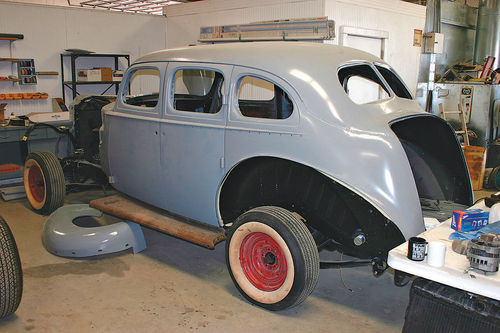

Luckily, the rear glass was a new type dubbed “Herculite” which was resistant to delaminating. It represented the first successful attempt at creating safety glass. Unless the rear glass is damaged or missing, the restorer of a ’40 Packard probably will not need to replace it.
The division bar centered in the two piece windshield generally needs replacement because over the years water becomes trapped internally, causing rust. In cold climates trapped water would freeze and since water expands when it freezes it typically caused the lower portion of the division bar to swell. The problem here is the lack of NOS or good used division bars. Bates had to have one made for each of his restored 1940 Packards. Despite their relatively simple appearance, they are not cheap to have manufactured. Bates opted to have his made with chrome-plated brass. Finding a way to properly cut the brass involved much work. In the end, water cutting proved to be the preferred method.
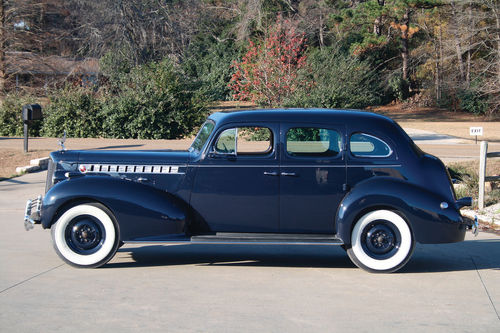
Vent windows pose their own potential for trouble. The frame around each needs to be removed carefully as does the chrome-plated latch. When re-plating the vent window latches, the chrome-plater needs to not plate the shaft where the latch mechanism attaches. The wind wings need careful inspection to make certain there are no loose components; if there are any, these need to be spot-welded in place prior to re-plating.
Window channels for the side glass are almost always rusted too severely to reuse. The steel channel for the featured One-Twenty was purchased from Steele Rubber Products and listed in the Cadillac section of their catalog. After it arrived, the channel was cut to the length required. These were then powder coated.
Modern flat glass is a little thinner than the original glass used in these Packards. The new channel is ideal for the new glass.
Window regulator springs “are precious,” says Bates. No source for NOS or a modern replacement appears to exist. About the only source is a parts car, though even that is becoming scarce. (Keep in mind that total Packard production from 1899-1956 was only about 1.35 million cars.)
Next month we’ll cover some details of the restoration project such as emblems, hubcaps, hood ornaments, handles, latches and interior upholstery.
















